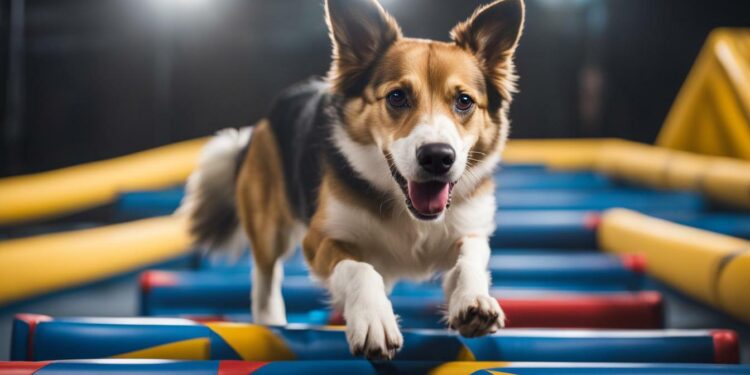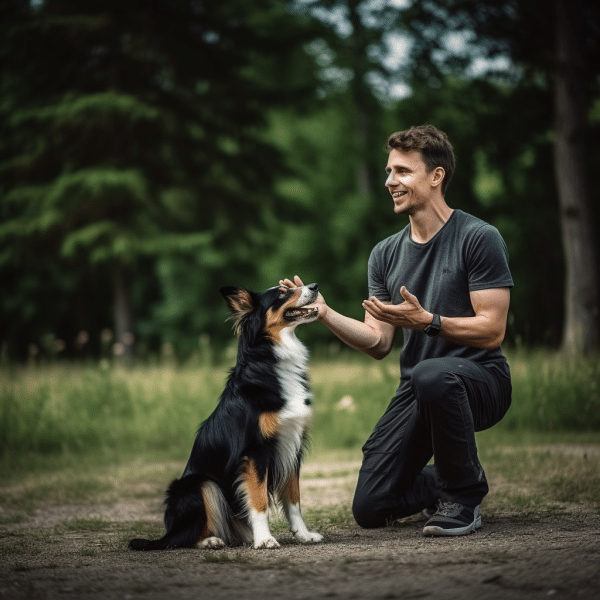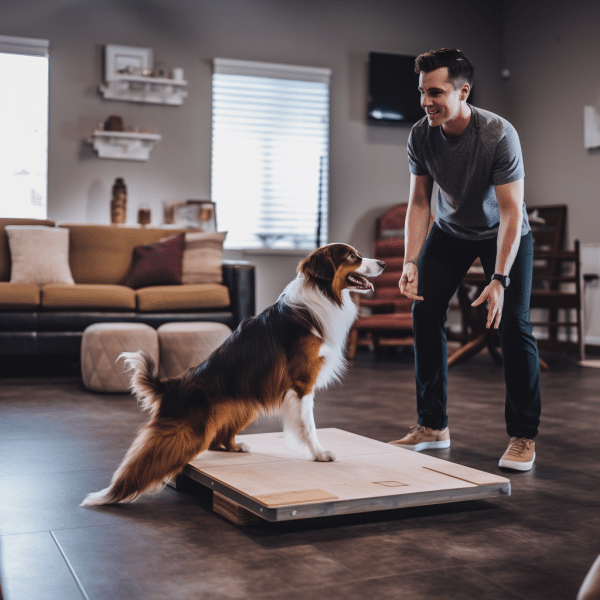Elevate Your Dog’s Skills: Advanced Training for a Happier

Advanced Dog Training: Welcome to the world of advanced dog training, where we take your furry friend’s abilities to the next level. In this article, we will explore how advanced training can enhance your dog’s skills and behavior, resulting in a well-behaved and happier pet. Whether your dog is a puppy or an adult, advanced training can provide them with the tools they need to excel.
At its core, advanced training goes beyond basic obedience commands and delves into more complex exercises and tasks. By elevating your dog’s abilities, you can tap into their full potential and unlock a whole new level of communication and cooperation. From improved obedience to enhanced agility, advanced training can transform your dog into a well-rounded companion.
So why invest in advanced training? The benefits are endless. Not only will your dog become more responsive and well-behaved, but they will also gain confidence and mental stimulation. This comprehensive approach to training ensures that your dog is equipped with the skills necessary to navigate various situations and environments.
Join us as we explore the world of advanced training and discover how it can elevate your dog’s abilities. Let’s embark on this journey together and unlock the true potential that lies within your furry companion.
The Benefits of Advanced Training
Advanced training for dogs offers a range of benefits that contribute to a well-behaved and happier pet. Through advanced training, dogs can develop improved obedience, enhanced agility, and better overall behavior. This comprehensive approach to training helps shape their behavior, making them more responsive and well-mannered companions.
One of the key advantages of advanced training is the development of better obedience skills. Dogs learn to respond promptly and reliably to commands, making them easier to manage in various situations. Whether it’s walking on a leash, sitting calmly, or coming when called, advanced training instills a higher level of obedience in dogs, promoting better behavior both at home and in public.
Furthermore, advanced training focuses on enhancing agility and athleticism in dogs. Through specialized exercises, dogs can improve their coordination, speed, and flexibility. This not only makes them more physically adept but also allows for more interactive and exciting activities, such as agility courses or competitive sports.
| Benefits of Advanced Training |
|---|
| Improved obedience |
| Enhanced agility |
| Better overall behavior |
Overall, advanced training helps create a stronger bond between a dog and their owner. The training process involves positive reinforcement techniques, teamwork, and consistent communication, which fosters a trusting and cooperative relationship. With advanced training, dogs become more attuned to their owner’s cues and commands, leading to a deeper connection and a happier pet-owner bond.
Ohio Northern University’s Polar Paws: An Example of Advanced Training
Ohio Northern University’s Polar Paws is a famous student group that shows how powerful advanced dog training can be. The group focuses on training service dogs to help military veterans and kids with disabilities. Polar Paws teaches dogs special skills that go beyond basic commands, so they can help with tasks like getting items and opening doors. The training also teaches dogs how to be comfortable and confident in all kinds of situations, so they can interact well with people of all ages and backgrounds.
| Benefits of Polar Paws Advanced Training: |
|---|
| 1. Enhanced obedience and responsiveness |
| 2. Specialized skills tailored to recipients’ needs |
| 3. Improved socialization and adaptability |
| 4. Increased confidence and calmness in various environments |
| 5. Lifelong support and continued training for recipients |
Ohio Northern University’s Polar Paws has a big impact. It creates a strong bond between service dogs and their human recipients. This bond shows how powerful the human-animal connection is. The dogs are not just helpers, but also trusted friends. They improve the lives of their human recipients.
The Training Process
When it comes to advanced dog training, the training process consists of several key components that work together to prepare dogs for more complex commands and behaviors. These components include basic training, socialization, and ultimately, advanced training. Each step in the process builds upon the previous one, creating a comprehensive training approach that sets the foundation for a well-behaved and highly-skilled dog.
Basic Training
Basic training forms the initial stage of the training process. It focuses on teaching essential commands such as sit, stay, come, and lie down. Dogs learn to respond to verbal cues and hand signals, developing the fundamental skills needed for more advanced training. Basic training also includes leash walking and crate training, helping dogs become more obedient and well-mannered.
Socialization
Socialization plays a crucial role in the training process as it exposes dogs to various people, animals, and environments. This helps them become comfortable and confident in different situations, reducing anxiety and fear-based behaviors. Socialization can include interactions with other dogs, meeting new people, exposure to different sounds and sights, and visits to various places. It teaches dogs how to navigate the world around them and promotes positive behavior.
Advanced Training
Once dogs have mastered basic commands and are well-socialized, they can progress to advanced training. This stage focuses on refining obedience skills, teaching more complex commands, and introducing specialized skills based on the dog’s intended purpose, such as search and rescue, service work, or agility training. Advanced training involves a combination of positive reinforcement, consistency, and patience to reinforce desired behaviors and eliminate any unwanted ones.
| Training Process | Description |
|---|---|
| Basic Training | Teaching essential commands and basic obedience skills |
| Socialization | Exposing dogs to different environments, people, and animals |
| Advanced Training | Refining obedience skills and teaching specialized commands |
The training process in advanced dog training is a gradual and systematic approach that takes into account the individual needs and abilities of each dog. By combining basic training, socialization, and advanced training, dogs can develop into well-rounded, obedient, and highly skilled companions.
Matching Dogs with Human Recipients
Matching dogs with human recipients is a crucial step in the advanced training process. It requires careful consideration and evaluation to ensure a successful partnership between a dog and their future owner. The goal is to find the right fit based on various factors such as the recipient’s lifestyle, needs, and the specific training requirements of the dog.
During this matching process, trainers and experts assess the temperament, energy level, and special skills of the dogs to determine their compatibility with potential recipients. They consider factors such as the recipient’s activity level, family dynamics, and any specific needs or preferences. This evaluation helps to identify dogs that can best meet the recipient’s requirements and form a strong bond with their new owner.
Additionally, the matching process also takes into account the dog’s training progress and the recipient’s ability to maintain and continue the training. A thorough understanding of both the dog and the recipient ensures that the partnership is successful and mutually beneficial.
Matching Dogs with Human Recipients: Key Considerations
When matching dogs with human recipients, several key considerations come into play to facilitate a harmonious partnership. These considerations include:
- The recipient’s lifestyle and activity level: It’s important to match a dog with a recipient whose lifestyle aligns with the dog’s energy level and exercise needs.
- The recipient’s needs and preferences: Matching dogs with recipients who have specific needs, such as mobility assistance or emotional support, ensures that the dog can provide the necessary support.
- The dog’s temperament and training progress: Assessing a dog’s temperament and training progress helps determine their suitability for specific recipients and their ability to adapt to different environments.
- Compatibility in skills and abilities: Matching dogs with recipients who can benefit from the dog’s specialized skills ensures a successful partnership where both parties can thrive.
By carefully considering these factors, trainers and experts can make informed decisions to match dogs with human recipients that result in strong and successful partnerships.
| Benefits of Matching Dogs with Human Recipients | Considerations for Successful Matches |
|---|---|
| The dog’s training is better suited to the recipient’s needs and lifestyle. | Assessing the recipient’s lifestyle and activity level |
| The recipient receives a dog that can provide the necessary support or assistance. | Understanding the recipient’s needs and preferences |
| A strong bond is formed between the dog and the recipient, leading to a successful partnership. | Evaluating the dog’s temperament and training progress |
| The recipient can benefit from the dog’s specialized skills. | Matching dogs and recipients based on compatibility in skills and abilities |
Understanding Normal Dog Behaviors
When it comes to understanding our canine companions, it’s important to recognize and appreciate their normal behaviors. Dogs have unique ways of communicating and interacting with the world around them, and one behavior that often raises eyebrows is crotch sniffing. While it may seem inappropriate to us humans, crotch sniffing is actually a natural behavior for dogs.
Crotch sniffing is an instinctual behavior driven by a dog’s highly developed sense of smell. Dogs have an incredible olfactory system that allows them to gather information about their environment through scent. When a dog sniffs another dog or a person’s crotch, they are simply gathering information about that individual.
“A dog’s sense of smell is so powerful that they can detect intricate details about a person or another animal just by sniffing their crotch,” says Dr. Jane Adams, a renowned canine behavior expert. “It’s their way of getting to know someone and learning about their scent.”
As dog owners, it’s important to understand that crotch sniffing is not an act of aggression or dominance. It’s simply a dog’s way of exploring and gathering information. Of course, it’s understandable that crotch sniffing can make some people uncomfortable, especially if it happens with unfamiliar dogs. In such cases, it’s important to communicate boundaries and redirect the dog’s attention to more appropriate behaviors.
Promoting Positive Socialization
Positive socialization requires understanding typical dog tendencies like crotch sniffing. Recognizing and respecting these traits makes socializing with other dogs safe and comfortable. To ensure our pets behave appropriately in social situations, proper training and guidance are essential.
Dogs use their sense of smell to travel, and crotch sniffing is one way they do it. Accepting this behavior as normal strengthens our bond with our dogs and gives them the socialization they need for a happy, well-rounded life.
| Table: Common Dog Behaviors and Their Meanings | |
|---|---|
| Behavior | Meaning |
| Crotch sniffing | A normal behavior driven by a dog’s sense of smell to gather information about individuals |
| Tail wagging | An expression of various emotions, including happiness, excitement, and sometimes anxiety or fear |
| Play bow | A signal indicating an invitation to play and engage in social interaction |
| Head tilt | A curious response to unfamiliar or interesting sounds |
| Pawing | A way to get attention or request something from humans |
Redirecting Undesirable Behaviors
Advanced training helps dogs improve their behavior. Basic training establishes obedience and socialization, while advanced training addresses specific unwanted behaviors. Positive reinforcement and consistent training help dogs learn which behaviors are desirable. Advanced training replaces undesirable behaviors with better ones. This ensures dogs are well-behaved and safe around people and their environment.
Common Undesirable Behaviors
Dogs can do things that are bad, like bark too much, jump on people, dig, chew on furniture, and pull on the leash. These behaviors can be a problem and even risky. But with training, dogs can learn better ways to behave. For instance, they can learn to obey quiet commands instead of barking a lot. They can also learn to sit calmly when meeting people. This helps dogs be happier and closer to their owners.
| Undesirable Behavior | Desired Behavior |
|---|---|
| Excessive Barking | Responding to quiet commands |
| Jumping on People | Sitting politely for greetings |
| Digging | Engaging in an appropriate activity, such as playing with toys |
| Chewing on Furniture | Chewing on designated toys or bones |
| Pulling on the Leash | Walking calmly on a loose leash |
By redirecting undesirable behaviors through advanced training, dogs can become well-adjusted members of society, leading to a more harmonious coexistence with their human counterparts.
Developmental Stages of Puppies
Puppies go through several important developmental stages as they grow and mature. Understanding these stages is crucial for providing appropriate care and training, ensuring the well-being and development of your furry friend.
Stage 1: Neonatal Period (0-2 weeks)
During the neonatal period, puppies are completely dependent on their mother for warmth, nutrition, and grooming. Their eyes and ears are closed, and they rely on their sense of touch and smell to navigate the world around them.
Stage 2: Transitional Period (2-4 weeks)
In the transitional period, puppies begin to open their eyes and ears, and their senses become more acute. They start to develop their motor skills and coordination, exploring their surroundings with more curiosity. Socialization with littermates and their mother becomes essential during this stage.
Stage 3: Socialization Period (4-12 weeks)
The socialization period is a critical phase in a puppy’s development. They become more aware of their environment and start to form relationships with their human family, other pets, and new experiences. It is crucial to expose them to a variety of people, places, and things to build their confidence and prevent fear or aggression issues later in life.
Stage 4: Juvenile Period (12 weeks to 6 months)
During the juvenile period, puppies experience rapid growth and maturation. They have boundless energy and are eager to explore their surroundings. Basic obedience and house training should be introduced at this stage to establish good behaviors and boundaries. This is also a great time to start more advanced training.
Puppy Development: Key Takeaways
- Puppies go through several developmental stages, from the neonatal period to the juvenile period, each with its own unique characteristics and needs.
- Proper socialization and exposure to different stimuli are crucial during the socialization period to ensure a well-adjusted and friendly adult dog.
- This is an ideal time to start implementing basic training and establishing boundaries and behaviors for your puppy.
- Consulting with a professional dog trainer or attending puppy classes can provide guidance and support during this critical stage of development.
Understanding and providing appropriate care and training during each developmental stage will help set your puppy up for success and contribute to their overall well-being and growth.
| Developmental Stage | Description |
|---|---|
| Neonatal Period | Puppies are completely dependent on their mother for warmth, nutrition, and grooming. Their eyes and ears are closed. |
| Transitional Period | Puppies start to open their eyes and ears, and their senses become more acute. They develop their motor skills and coordination. |
| Socialization Period | Puppies become more aware of their environment and start to form relationships. Socialization with people, pets, and new experiences is crucial. |
| Juvenile Period | Puppies experience rapid growth and maturation. Basic obedience and house training should be introduced. |
Building a Solid Foundation: Basic Training for Advanced Success
To achieve success in dog training, start with basic training. This sets the stage for advanced techniques and a well-behaved dog. Clear communication is key, which means reinforcing commands and rewarding desirable behaviors. Use gestures, vocal cues, and rewards to help the dog learn and become more responsive.
Basic training teaches dogs good manners and socialization skills. They learn how to behave in different situations by being exposed to various environments, people, and animals. This helps them become better pets and prepares them for advanced training where they may encounter more stimuli.
Table: Basic Commands for Building a Solid Foundation
| Command | Description |
|---|---|
| Sit | The dog learns to sit on command, promoting calmness and attentiveness. |
| Stay | The dog learns to remain in place until given the signal to move, promoting patience and self-control. |
| Come | The dog learns to come to the owner upon hearing the command, promoting responsiveness and recall. |
| Leave it | The dog learns to ignore or let go of an object upon command, promoting impulse control and safety. |
| Heel | The dog learns to walk calmly and closely beside the owner, promoting leash manners and attentiveness. |
By establishing a solid foundation through basic training, dog owners can set their pets up for advanced success in training. This foundation provides the necessary structure and discipline that allows dogs to learn and excel in more complex tasks and behaviors. It also strengthens the bond between the owner and the dog, creating a relationship based on trust, understanding, and effective communication.
Taking Obedience to the Next Level: Advanced Commands
Advanced training goes beyond basic obedience commands and introduces more complex commands that challenge dogs to demonstrate higher levels of focus, discipline, and responsiveness. These advanced commands not only enhance a dog’s obedience skills but also strengthen the bond between the dog and their owner. By mastering advanced commands, dogs become more attentive and reliable, showcasing their advanced training and capabilities.
Advanced commands can include tasks such as “sit-stay,” “down-stay,” “heel,” and “recall” with increased distractions and longer durations. These commands require dogs to hold their positions regardless of surrounding stimuli or temptations, showcasing their self-control and discipline. Through consistent practice and positive reinforcement, dogs can learn to execute these commands reliably, even in challenging environments.
“Advanced commands play a crucial role in off-leash control and safety. Dogs that have mastered advanced commands like ‘drop it,’ ‘leave it,’ and ‘wait’ have a higher level of impulse control and are less likely to engage in dangerous behaviors,” says dog trainer and behaviorist, Dr. Lisa Peterson.
Introducing advanced commands is a gradual process that builds upon the foundation of basic training. Dogs should have a solid understanding and proficiency in basic commands before advancing to more complex ones. Patience, consistency, and positive reinforcement are key during this process, ensuring that dogs feel motivated and rewarded for their efforts.
| Advanced Commands | Description |
|---|---|
| Sit-Stay | Dog is trained to sit and remain in position until released, regardless of distractions. |
| Down-Stay | Dog is trained to lie down and remain in position until released, even with distractions present. |
| Heel | Dog walks calmly by the owner’s side, focusing on their handler’s movements. |
| Recall | Dog is trained to come when called, even in distracting or tempting situations. |
By incorporating advanced commands into training sessions, dog owners can take their dog’s obedience to the next level. These commands not only enhance a dog’s listening skills but also promote mental stimulation and challenge, leading to a happier and more well-rounded pet.
Enhancing Agility and Performance: Canine Skills in Advanced Training
Advanced training plays a crucial role in enhancing a dog’s agility and performance through the development of specialized canine skills. These skills go beyond basic obedience and provide dogs with the ability to perform complex tasks and maneuvers. By focusing on agility training, advanced programs help dogs become more agile, nimble, and responsive in various situations.
One key aspect of enhancing agility in advanced training is through obstacle courses. These courses challenge dogs to navigate through ramps, tunnels, jumps, and other obstacles, requiring them to use their physical abilities and mental agility to complete the course successfully. The training process involves teaching dogs to follow hand and verbal cues, improving their coordination, speed, and overall performance.
Another important component of advanced training is the development of specific skills that are beneficial in various fields, such as search and rescue or competitive dog sports. These skills can include scent detection, tracking, retrieving, and even advanced obedience commands. By mastering these skills, dogs become highly capable in their respective roles and excel in their performance.
The Importance of Canine Skills in Advanced Training
Canine skills, developed through advanced training, are not only impressive to witness but also serve practical purposes in real-world scenarios. Dogs trained in search and rescue can use their heightened senses and agility to locate missing persons or detect specific scents. In competitive dog sports, such as agility trials or obedience competitions, canine skills are essential for achieving top performance and outperforming other participants.
Through the advanced training process, dogs are not only physically conditioned but also mentally stimulated. This stimulation helps increase their problem-solving abilities, adaptability, and overall intelligence. Additionally, the bond between dog and owner is strengthened through the shared experience of advanced training, leading to a deeper level of trust and collaboration.
| Benefits of Enhancing Canine Agility and Performance |
|---|
| Improved physical fitness and overall health |
| Enhanced mental stimulation and problem-solving skills |
| Increased adaptability and responsiveness in various situations |
| Heightened bond and collaboration between dog and owner |
Overall, advanced training programs that focus on enhancing agility and developing canine skills provide dogs with the necessary tools to excel in various fields and lead fulfilling lives. With their newfound agility, mental sharpness, and specialized capabilities, these dogs showcase the incredible potential that advanced training can unlock.
The Impact of Advanced Training on Pet-Owner Bonding
Advanced training for dogs goes beyond the development of skills and obedience. It also plays a significant role in strengthening the bond between pets and their owners. Through the training process, dogs learn to trust and rely on their owners, creating a deeper connection and understanding. This enhanced bond contributes to a happier and more fulfilling relationship for both parties involved.
One of the key elements of advanced training is the increased communication and cooperation between the dog and the owner. As the dog learns advanced commands and skills, the owner becomes more proficient in understanding their pet’s needs and desires. This mutual understanding fosters a sense of companionship and trust, leading to a stronger bond.
“Advanced training has allowed me to build a deeper connection with my dog. The training process has taught us to work together as a team, and the bond we’ve formed is incredible. It’s not just about obedience; it’s about building a lifelong partnership.” – Pet Owner
Additionally, the training journey itself provides opportunities for quality time spent together. From attending training sessions to practicing commands and skills at home, these shared experiences further strengthen the pet-owner bond. The dedication and effort put into advanced training also demonstrate the owner’s commitment to their pet’s well-being, fostering a sense of love and mutual respect.
In conclusion, advanced training not only enhances a dog’s abilities but also has a profound impact on the bond between pet and owner. Through improved communication, shared experiences, and a mutual sense of trust, the training process creates a stronger connection that lasts a lifetime.
| Benefits of Advanced Training | Impact on Pet-Owner Bonding |
|---|---|
| Improved obedience | Enhanced communication |
| Enhanced agility and performance | Deeper understanding and trust |
| Better overall behavior | Quality time spent together |
Continuing the Journey: Lifelong Learning and Development
In the world of advanced dog training, the journey doesn’t end once the training program is complete. Lifelong learning and ongoing development are crucial for dogs to maintain their skills and continue to grow. Just like humans, dogs benefit from mental stimulation, physical activity, and new challenges throughout their lives.
The training journey is a continuous process that involves reinforcing learned behaviors, introducing new commands, and expanding on existing skills. It’s important for dog owners to understand that advanced training is not a finite destination but rather a stepping stone to a lifetime of learning and development. This ongoing education helps dogs stay mentally sharp, physically fit, and emotionally balanced.
“A well-trained dog is a happy dog,” says renowned dog trainer, John Davis.
“Just as we humans thrive when we’re constantly learning and growing, dogs also flourish when they have opportunities for continued education and enrichment. It strengthens the bond between dog and owner and ensures a harmonious and fulfilling life together.”
The Benefits of Lifelong Learning
Continued education for dogs offers a range of benefits, including:
- Improved obedience and responsiveness
- Enhanced problem-solving skills
- Increased mental and physical stimulation
- Reduced behavioral issues
- Heightened socialization and adaptability
By engaging in lifelong learning, dogs can maintain their advanced training achievements and build upon them to reach new levels of mastery. Whether it’s participating in advanced obedience classes, exploring agility training, or even learning new tricks, dogs thrive when presented with new challenges and opportunities to grow.
| Training Journey Milestones | Key Features |
|---|---|
| Foundation Training | Building core obedience skills and establishing a strong bond with the owner. |
| Advanced Training | Expanding on foundational skills, introducing complex commands, and refining behaviors. |
| Lifelong Learning | Continuing education to maintain skills, learn new commands, and engage in mental and physical enrichment activities. |
Dog owners must give constant learning and growth opportunities for their pets. Through lifelong learning, we can ensure our dogs have meaningful lives and astound us with their abilities.
Exploring Specialized Training Programs
Advanced dog training programs provide many benefits, but there are also customized programs for specific needs. These programs give canines additional training and specialized skills to do certain tasks or help people with special needs.
Service Dog Training
Service dog training trains dogs to help disabled people. Highly trained canines can retrieve goods, open doors, provide stability, and alert to medical concerns. They undertake intensive training to fulfill their handlers’ demands and give crucial daily support.
Therapy Dog Training
Therapy dog training trains canines to comfort and support people in hospitals, nursing homes, schools, and rehabilitation centers. These canines are trained to be gentle and peaceful so they can connect with people of all ages and give therapeutic benefits through their presence and affection.
Search and Rescue Training
Search and rescue programs train canines to find and rescue people in natural catastrophes and missing persons cases. These highly trained canines sense scents, navigate difficult terrain, and communicate with their humans to find and help the needy.
| Specialized Training Programs | Description |
|---|---|
| Service Dog Training | Training dogs to assist individuals with disabilities by performing specific tasks. |
| Therapy Dog Training | Training dogs to provide comfort and emotional support to individuals in various settings. |
| Search and Rescue Training | Training dogs to locate and rescue individuals in emergency situations. |
These unique dog training programs demonstrate its adaptability. They let dogs use their particular skills to help people and communities. Dog owners and lovers can find new ways for their dogs to grow and contribute by investigating specialized training programs.

Conclusion
Dog training is important for good behavior and happy pets. Advanced training is especially beneficial for obedience and agility. It also helps dogs respond well to commands. Polar Paws is a student organization that trains service dogs for veterans and children with disabilities. This program emphasizes the importance of advanced training for preparing dogs for specific roles.
Dogs are trained in three stages: basic, socialization, and advanced. This prepares them with the skills they need for their roles. During advanced training, dogs are matched with human partners for a better partnership. Owners must understand normal dog behaviors, like crotch sniffing. Advanced training helps owners redirect negative behaviors.
It’s important to know the different stages of puppy development. This helps owners give proper care and training. By nurturing them during growth, owners can set their puppies up for success. This prepares them for advanced training and lifelong learning.
FAQ
What is advanced dog training?
Advanced dog training is a program that goes beyond basic training to elevate a dog’s abilities and skills.
Why is advanced training crucial for dogs?
Advanced training enhances a dog’s behavior, responsiveness, and overall performance, resulting in a well-behaved and happier pet.
Can you provide an example of advanced dog training?
Ohio Northern University’s Polar Paws is an organization that trains service dogs to assist military veterans and children with disabilities, showcasing advanced training techniques.
What does the training process involve?
The training process includes basic training, socialization, and advanced training to prepare the dogs for their specific roles as service dogs.
How are dogs matched with human recipients?
During the advanced training phase, dogs are carefully matched with human recipients based on their specific needs and requirements.
Is crotch sniffing a normal behavior for dogs?
Yes, crotch sniffing is a normal behavior for dogs as they use their sense of smell to gather information about their surroundings.
Can training redirect undesirable behaviors like crotch sniffing?
Yes, through training, dogs can be taught alternative behaviors and redirected away from undesirable actions, including crotch sniffing.
Why is understanding the developmental stages of puppies important?
Understanding the different developmental stages of puppies allows for appropriate care and training, ensuring their well-being and healthy growth.
What is the importance of basic training for advanced success?
Building a solid foundation through basic training is essential for achieving advanced success in dog training, as it establishes key obedience and behavior patterns.
What are advanced commands in dog training?
Advanced commands are more complex cues and behaviors taught beyond basic obedience training, further enhancing a dog’s skills and abilities.
How does advanced training enhance agility and performance?
Advanced training focuses on developing canine skills, including agility, which helps dogs become more agile, coordinated, and perform at peak levels.
Does advanced training impact pet-owner bonding?
Yes, advanced training strengthens the bond between pets and their owners, as it fosters communication, trust, and mutual understanding.
Is training a lifelong journey for dogs?
Yes, training is a lifelong journey for dogs, as ongoing learning and development are necessary to maintain and improve their skills throughout their lives.
Are there specialized training programs available?
Yes, there are specialized training programs that cater to specific needs and goals such as therapy dog training, search and rescue training, and more.
What is the role of advanced training in dog ownership?
Advanced training plays a significant role in enhancing the overall experience of dog ownership, resulting in a well-behaved, skilled, and happy companion.
Do you have any additional questions about advanced dog training?
If you have any additional questions or need further information about advanced dog training, please feel free to reach out to us.






